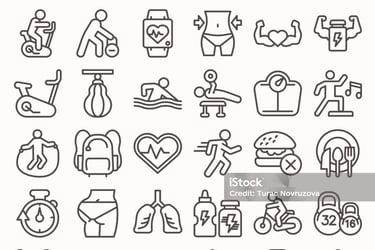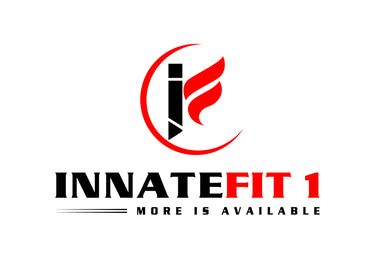Visit Innatefit1.com for exercise wear and equipment!!!
Paralyzed by Possibility: How Decision Fatigue Is Sabotaging Your Fitness Motivation
Paralyzed by too many workout options? Learn how decision fatigue can erode fitness motivation and gym attendance. Discover how a minimalist fitness approach can reduce overwhelm, boost motivation, and help you stick to consistent workouts. Unlock practical steps to simplify your fitness routine today.
SELF-HELPWORKOUTSHEALTHY LIFESTYLESTRENGTH TRAININGHEALTHMOTIVATION
Joseph Battle
6/23/20256 min read


Introduction: The Paradox of Choice Hits the Gym
Imagine this: you’ve carved out precious time in your busy day for exercise. You open your fitness app—or scan through your mental menu—and are greeted with an endless stream of workout possibilities. Should you tackle HIIT or try yoga?
Is today for upper body strength or core work? Before you know it, your allotted time slips away, and you decide—almost by accident—that you’ll just work out tomorrow.
In our hyper-connected world, the sheer volume of exercise options can work against our best intentions. This “exercise options overwhelm” is not just a modern inconvenience; it’s a real psychological barrier that erodes fitness motivation.
In this post, we’ll explore how decision fatigue affects gym attendance, why too many workout options cause skipping the gym, and how a minimalist fitness approach might be the solution you need.
Understanding Decision Fatigue—Why More Is Less
Decision fatigue refers to the deterioration in the quality of decisions made by an individual after a prolonged period of decision-making. While it may sound like a buzzword, it has deep roots in psychological research.
When faced with too many choices, our brains become overworked, leading to avoidance, procrastination, or subpar decision-making. In the context of fitness, this means that deciding what kind of gym session to do can become so taxing that you end up skipping it entirely.
The gym, once a haven for self-improvement, has evolved into a marketplace offering endless possibilities. From spin classes to CrossFit, Zumba to kettlebell circuits, and a menu of virtual programs at your fingertips, the options are dizzying.
While variety can spark excitement, it quickly gives way to confusion, particularly when you’re mentally exhausted from the rest of your day. Thus, having too many workout options can cause us to skip the gym because our brains crave simplicity, especially when willpower reserves are low.
The Vicious Cycle—How Decision Fatigue Affects Gym Attendance
As decision fatigue sets in, motivation begins to wane. After making countless choices at work, at home, or while scrolling through social media, most people have little mental energy left for yet another round of selections regarding fitness. This often leads to what researchers call “choice paralysis,” where no decision feels right, resulting ironically in the least healthy choice: doing nothing at all.
This cycle can erode your motivation to stay fit over time. You might start to feel guilty for missing workouts or resentful about the effort required to choose the “right” exercise. The result is a subtle but powerful erosion of your commitment to health.
Gym attendance, once a staple of your weekly routine, starts to drop off. You may rationalize skipping the gym due to your busy life, not realizing that the true culprit is the mental exhaustion created by an overload of choices. Consequently, decision fatigue affects gym attendance by creating invisible walls of indecision.
The Overwhelming Menu—Why More Workouts Aren’t Always Better
The fitness industry thrives on novelty. New workout classes, equipment, and routines are marketed daily. Apps promise tailored plans, trainers offer bespoke regimens, and social media brims with highlight reels of the “latest and greatest” exercises. Unfortunately, this stimulation overload leads to analysis paralysis.
One study from Columbia University revealed that when consumers were offered more kinds of jam, they were less likely to buy any. The same phenomenon occurs with overwhelming exercise options.
Too many choices can make your brain feel like it’s walking through mental quicksand, sapping energy and stalling momentum. Motivation becomes scattered; instead of focusing on consistency, you spend mental energy second-guessing and searching for the “perfect” workout. Ironically, the abundance intended to empower often limits action. When too many workout options cause skipping the gym, it’s time to rethink the value of choice.
Minimalist Fitness Approach—The Power of Streamlining Your Routine
So what’s the antidote to analysis paralysis? Enter the minimalist fitness approach. By intentionally narrowing your exercise selection, you ease the mental burden associated with workout planning. Minimalism doesn’t mean monotony; it simply eliminates unnecessary complexity, making gym attendance a practical, automatic part of your routine.
This approach is rooted in behavioral psychology, where establishing habits, reducing friction, and creating routines are key to sustainable change.
For instance, having a default workout (e.g., 30 minutes of brisk walking on the treadmill or a simple bodyweight circuit) for days when decision fatigue sets in ensures you move your body, regardless of motivation. Streamlining your choices increases the likelihood of action, not just intention.
Practical Strategies to Combat Exercise Options Overwhelm
Adopting a minimalist fitness approach requires intentionality and planning. Start by selecting 2–3 core workouts that you genuinely enjoy and can perform with minimal setup.
Make these your “default settings.” For example, rotate between full-body strength training, a functional high-intensity interval training (HIIT) session, and a moderate outdoor run. By limiting options, you remove guesswork and decision fatigue from the equation.
Additionally, consider developing a set workout schedule, such as Monday for strength training and Wednesday for cardio. This planned routine reduces cognitive load, allowing you to reserve willpower for more important decisions in your life.
You might also try pre-programming your music playlists, gym attire, or even meals after a workout. With fewer variables to consider, attending the gym becomes a seamless part of your day.
Rekindling Fitness Motivation—From Overwhelm to Action
Once you reduce choice overload, you’ll likely notice a resurgence in your motivation to stay fit. Routinized workouts transform exercise into a “no-brainer” activity, less susceptible to mood swings, fatigue, or the unpredictable challenges of daily life. As your confidence builds through consistency, you create an upward spiral of motivation and achievement.
Moreover, by decluttering your workout calendar, you free up mental space to enjoy your fitness journey without the persistent background chatter of “Am I doing enough?” or “Should I switch things up?”
Remember, lasting results don’t demand infinite variety—they require commitment and follow-through. Recognizing how decision fatigue affects gym attendance empowers you to reclaim control over both your schedule and your sense of well-being.
The Minimalist Workout Transformations
Many seasoned athletes and fitness enthusiasts have adopted a more straightforward approach and reaped incredible benefits. Take the example of Olympic sprinters who focus their entire regimen around a handful of core exercises.
Or busy professionals who swear by alternating two basic workouts, citing better adherence and less stress. Their secret isn’t a magic pill, but rather, the elimination of needless decision-making.
Similarly, people recovering from burnout or those just starting their fitness journeys report the highest success rates when they commit to a small, manageable repertoire of exercises. The minimalist fitness approach isn’t just for the time-crunched or the overwhelmed; it’s for anyone ready to break free from the cycle of indecision. By choosing less, you do more, and that is the ultimate motivation for fitness.
When to Add Back Variety—Smart Choices for Advanced Progress
Minimalism doesn’t mean stagnation. Once you establish your foundational routine, variety can be slowly reintroduced in intentional, measured ways. For instance, after several weeks with your core workouts, experiment with a new exercise or technique—one at a time. This keeps things fresh without overwhelming your decision-making bandwidth.
Schedule “variety days” sparingly, perhaps once every few weeks, and prepare for them in advance. This way, you can enjoy the excitement of something new while maintaining the consistency that drives results. In essence, variety becomes a tool for growth rather than an obstacle to action. You’re in control, not at the mercy of endless choices.
Creating Your Minimalist Fitness Playbook—A Step-By-Step Guide
Ready to put theory into practice? Start by writing down every workout you might enjoy. Review this list and circle the top three that genuinely excite you and fit into your lifestyle. Commit to doing only these workouts for the next 30 days. During this period, keep a journal describing your energy, motivation, and gym attendance.
Next, eliminate unnecessary workout gear, complicated tracking apps, and social media comparisons. Focus instead on doing, rather than planning. After a month, assess your progress and celebrate your consistency. The results will speak for themselves—less stress, better attendance, and a renewed sense of control.
Conclusion: One Choice, One Step, One Workout at a Time
In a world overflowing with possibilities, sometimes the bravest thing you can do is choose less. Decision fatigue isn’t a weakness—it’s a natural result of our overstimulated culture.
However, by understanding how decision fatigue affects gym attendance and exercise options overwhelm, you can make conscious changes that reignite your fitness motivation. Embrace a minimalist fitness approach today, because the simplest workout is often the one you’ll do.






